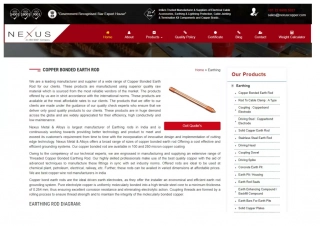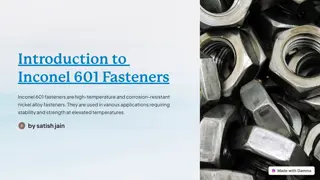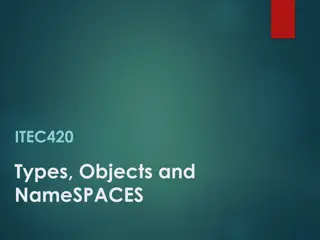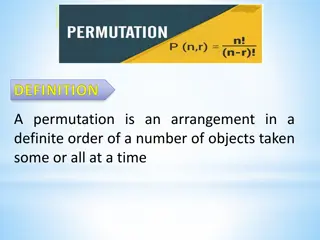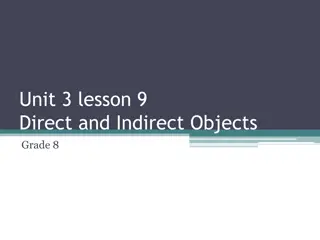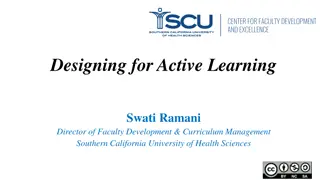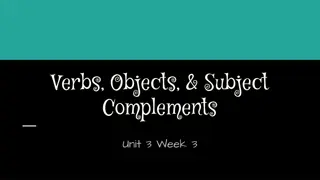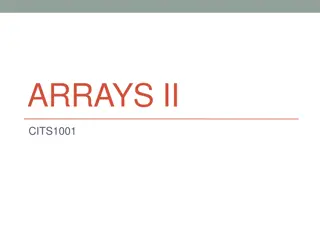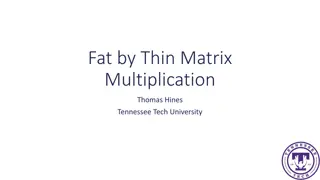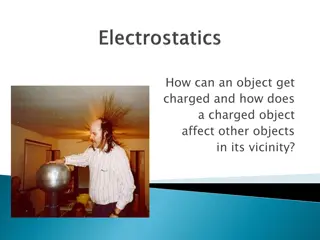Multi-threaded Active Objects: Issues and Solutions
The document delves into the realm of multi-threaded active objects, exploring their principles, limitations, related works, and solutions. It covers topics such as asynchronous method calls, first-class futures, and the risks associated with active objects. Additionally, it compares various approaches like cooperative multithreading and declarative parallelization in Java. The goal is to provide insights on the challenges and advancements in handling concurrency and distribution in software systems.
Download Presentation

Please find below an Image/Link to download the presentation.
The content on the website is provided AS IS for your information and personal use only. It may not be sold, licensed, or shared on other websites without obtaining consent from the author. Download presentation by click this link. If you encounter any issues during the download, it is possible that the publisher has removed the file from their server.
E N D
Presentation Transcript
Multi-threaded Active Objects Ludovic Henrio, Fabrice Huet, Zsolt Istv n June 2013 Coordination@Florence Oct. 2012
Agenda Introduction: Active Objects II. Issues and Existing Solutions III.Multi-active Objects: Principles IV.Experiments and Benchmarks V. Conclusion and Future Works
ASP and ProActive Active objects Asynchronous method calls / requests With implicit transparent futures A beta = newActive ( A , ); V foo = beta.bar(param); .. foo.getval( ); f foo = beta.bar(p) foo.getval( ) foo.getval( ) foo.getval( ) WBN!! Caromel, D., Henrio, L.: A Theory of Distributed Object. Springer-Verlag (2005)
First Class Futures f delta.snd(foo) Active objects are the unit of distribution and concurrency (one thread per AO / no data shared) ProActive is a Java library implementing ASP
Agenda I. Introduction: Active Objects Issues and Existing Solutions III.Multi-active Objects: Principles IV.Experiments and Benchmarks V. Conclusion and Future Works
Active Objects Limitations AO2 AO1 No data sharing inefficient local parallelism Parameters of method calls/returned values are passed by value (copied) No data race-condition simpler programming + easy distribution Risks of deadlocks, e.g. no re-entrant calls Active object are single threaded Re-entrance: Active object deadlocks by waiting on itself (except if first-class futures) Solution: Modifications to the application logic difficult to program
Related Work (1): Cooperative multithreading Creol, ABS, and Jcobox: Active objects & futures Cooperative multithreading l All requests served at the same time l But only one thread active at a time l Explicit release points in the code can solve the re-entrance problem More difficult to program: less transparency Possible interleaving still has to be studied
Related Work (2): JAC Declarative parallelization in Java Expressive (complex) set of annotations Reactive objects Simulating active objects is possible but not trivial Our alternative view: new multithreaded AOs A simple version of JAC for simple active objects la ASP multi-active objects efficient and easy to program
Agenda I. Introduction: Active Objects II. Issues and Existing Solutions Multi-active Objects: Principles IV.Experiments and Benchmarks V. Conclusion and Future Works
Multi-active objects A programming model that mixes local parallelism and distribution with high-level programming constructs Execute several requests in parallel but in a controlled manner Provided add, add and monitor are compatible add() { } monitor() { } add() { } Note: monitor is compatible with join
Scheduling Requests An optimal request policy that maximizes parallelism : Schedule a new request as soon as possible (when it is compatible with all the served ones) Serve it in parallel with the others Serves l Either the first request l Or the second if it is compatible with the first one (and the served ones) l Or the third one requests can execute at the same time and can be re-ordered Compatibility = compatible
Declarative concurrency by annotating request methods Groups (Collection of related methods) Rules (Compatibility relationships between groups) Memberships (To which group each method belongs)
More efficiency: Thread management Too many threads can be harmful: memory consumption, too much concurrency wrt number of cores Possibility to limit the number of threads Hard limit: strict limit on the number of threads Soft limit: prevents deadlocks Limit the number of threads that are not in a WBN
Dynamic compatibility: Principle Compatibility may depend on object s state or method parameters Provided the parameters of add are different (for example) add(int n) { } add(int n) { }
Dynamic compatibility: annotations Define a common parameter for methods in a group a comparison function between parameters (+local state) to decide compatibility Returns true if requests compatible
Hypotheses and programming methodology We trust the programmer: annotations supposed correct static analysis or dynamic checks should be applied in the future Without annotations, a multi-active object runs like an active object If more parallelism is required: 1. Add annotations for non-conflicting methods 2. Declare dynamic compatibility 3. Protect some memory access (e.g. by locks) and add new annotations More parallelism More complex code / better Easy to program Difficult to program performance
Agenda I. Introduction: Active Objects II. Issues and Existing Solutions III.Multi-active Objects: Principles Experiments and Benchmarks V. Conclusion and Future Works
Experiment #1: NAS parallel benchmark Pure parallel application (Java) No distribution Comparison with hand-written concurrent code Shows that with multi-active objects, parallel code Is simpler and shorter With similar performance
Multi-active objects are simpler to program Original vs. Multi-active object master/slave pattern for NAS
NAS results Less synchronisation/concurrency code With similar performances
Experiment #2: CAN Each peer is implemented by a (multi) active object and placed on a machine Parallel and distributed Parallel routing
Experiment #2: CAN Significant speedup due to parallelisation of communications, while controlling which communications are performed in parallel With only a few annotations !
Agenda I. Introduction: Active Objects II. Issues and Existing Solutions III.Multi-active Objects: Principles IV.Experiments and Benchmarks Conclusion and Future Works
Conclusion (1/2): a new programming model Active object model Easy to program Support for distribution Local concurrency and efficiency on multi-cores Transparent multi-threading Simple annotations Possibility to write non-blocking re-entrant code Parallelism is maximised: Two requests served by two different threads are compatible Each request is incompatible with another request served by the same thread (that precede it) globally distributed objects A programming model for locally concurrent and
Conclusion (2/2): Results and Status Implemented multi-active objects above ProActive Dynamic compatibility rules and thread limitation Case studies/benchmarks: NAS, CAN Specified SOS semantics and proved maximal parallelism Next steps: Use the new model (new use-cases and applications) Prove stronger properties, mechanised formalisaiton Static guarantees / verification of annotations
Thank you Ludovic Henrio, Fabrice Huet, Zsolt Istv n Ludovic.henrio@cnrs.fr Fabrice.huet@inria.fr zsolt.istvan@gmx.net NB: The greek subtitles (i.e. the operational semantics) can be found in our paper
Active Objects Asynchronous communication with futures Location transparency Composition: An active object (1) a request queue (2) one service thread (3) Some passive objects (local state) (4) 1 4 2 3


